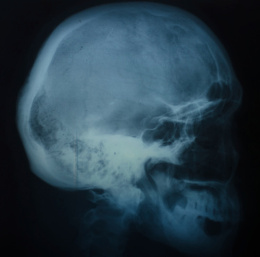A skull fracture is most likely to occur in the event of blunt force trauma to the head. The following Buzzle write-up provides information on the symptoms of such an injury.

The human skull is a bony structure that encases the brain, thereby protecting the structures within the brain from damage in the event of an injury. Though the skull is a very hard structure that is difficult to break, the bones (frontal, parietal, temporal, occipital, sphenoid, or ethmoid bones) could develop a break or fracture in case of a head injury. However, the cranial bones will break only if the impact is too intense. Blunt force trauma to the head could occur due to falls, automobile accidents, physical assault, etc.
Symptoms
Fractures are classified into simple (break in the bone in the absence of damage to the skin), linear (hairline fracture without any depression or splintering of the cranial bone), depressed (break in the bone with the bone depressed towards the brain), or compound (injury involving a break in the bone, damaged skin, and splintering of the bone) skull fracture. When the bone is broken without any changes or displacement in the alignment of the bones, it is referred to as a closed fracture. An open fracture is said to occur when the bones of the skull are displaced and the blood vessels between the skull and outer membrane get ruptured. An open fracture is very dangerous, as there's a high risk of bacterial infection in the brain.
When the base of the skull is broken, it may lead to the development of tears in the meninges (membranes that envelop the brain). It causes them to rupture and bleed. This is called a basilar fracture. The symptoms include bruising of the scalp, headache, nausea, vomiting, dizziness, loss of consciousness, or even seizures. In extreme cases, the affected person may slip into a coma. The typical symptoms of basilar fracture include raccoon eyes and battle's signs (bruising) behind the ear.
There are two temporal bones on either side of the head. These bones are located under the ear in the skull. These protect the area of the brain that controls speech, hearing, memory, and behavior. In case of a temporal fracture, one may experience symptoms such as loss of hearing, nausea, vomiting, dizziness, facial nerve paralysis, or leakage of cerebrospinal fluid from the nose and ears.
In general, the symptoms include the following:
- Bleeding from ears, nose, around the eyes, and even from the open wound in head
- Bruising around the eyes and ears
- Changes in the eye pupils (pupils are not reactive to light)
- Convulsions
- Confusion
- Balancing problems
- Clear or bloody fluid oozing from ears or nose
- Loss of consciousness
- Nausea
- Vomiting
- Headache
- Drowsiness
- Slurred speech
- Stiff neck
- Restlessness
- Depressed area or indentation in skull
- Tinnitus
- Amnesia
- Numbness in one arm or leg
- Double vision
Symptoms in Children
Children could get affected if they fall down from a height and land directly on their head. The symptoms in children are as follows:
- Swelling on the head
- Fluid from head, ear, nose
- Bulging fontanel in infants
- Dent in the head
- Dizziness
- Seizures
- Loss of consciousness
- Pain
- Nausea
- Vomiting
- Severe headache
Treatment
The affected person might take around 3 to 6 months to heal, or longer depending on the injury. The treatment would vary, depending on the type of fracture. In case of an open wound, the doctor will first remove dirt, blood, dead tissue, etc., from the scalp, and dress the wound. The treatment might also involve repairing the damaged blood vessels. If the bone fragments have damaged the meninges or brain tissue, surgery is required to remove these fragments. The damaged tissue is repaired and the patient is given antibiotics to reduce the risk of infections. Physical therapy may also be required.
In case you come across someone with such an injury, do not move the affected person. Seek medical help immediately. Never remove any protruding object from the brain and never give him/her any medications without consulting a medical professional. Even if the person has a closed fracture, and does not show any outward signs of grave injury, do not leave his/her side till help arrives.
Disclaimer:
The information provided in this article is solely for educating the reader. It is not intended to be a substitute for the advice of a medical expert.


 The human skull is a bony structure that encases the brain, thereby protecting the structures within the brain from damage in the event of an injury. Though the skull is a very hard structure that is difficult to break, the bones (frontal, parietal, temporal, occipital, sphenoid, or ethmoid bones) could develop a break or fracture in case of a head injury. However, the cranial bones will break only if the impact is too intense. Blunt force trauma to the head could occur due to falls, automobile accidents, physical assault, etc.
The human skull is a bony structure that encases the brain, thereby protecting the structures within the brain from damage in the event of an injury. Though the skull is a very hard structure that is difficult to break, the bones (frontal, parietal, temporal, occipital, sphenoid, or ethmoid bones) could develop a break or fracture in case of a head injury. However, the cranial bones will break only if the impact is too intense. Blunt force trauma to the head could occur due to falls, automobile accidents, physical assault, etc.